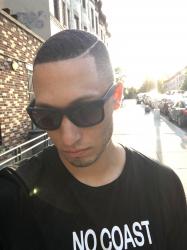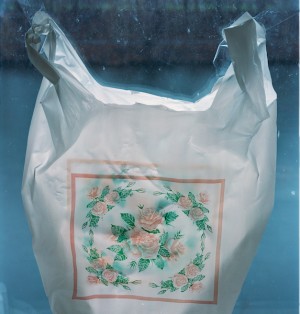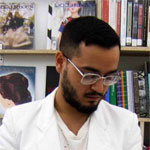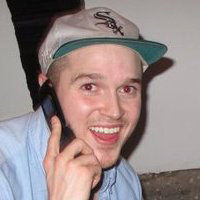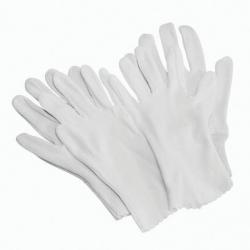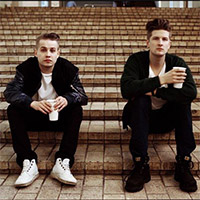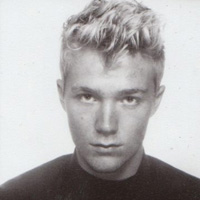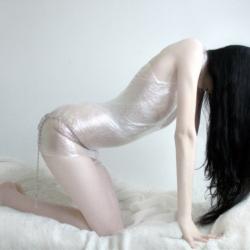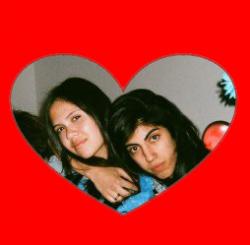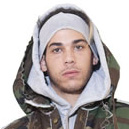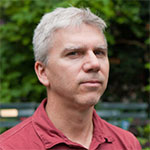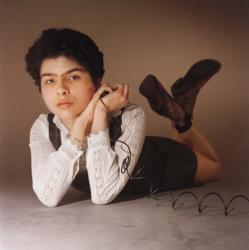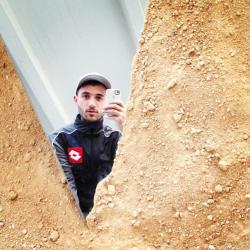Lafayette Anticipation associate curator Anna Colin talks to artist Tyler Coburn about Ergonomic Futures, a speculative project engaged with art, design, science, anthropology and writing. In this interview, Coburn discusses the research, production process and network of collaborators of a multilayered project ultimately concerned with the futures of humankind. Anna Colin: When one comes across your museum seats Ergonomic Futures (2016—) in contemporary art exhibitions—and soon in natural history, fine art, and anthropology museums—they look… [read more »]
Wether (excerpt) | Andrew Norman Wilson

Andrew Norman Wilson, Robin Williams window shade. Vegetable tanned leather, acrylic paint, 3D powder print, steel chains, swimbait fish hooks.
In the summer of 2014, Nicole Russo and I started planning a show at her gallery, Chapter NY, together. The gallery is a single room. It has a recessed doorway that is also a window, and an air conditioner pierces the glass above the door. The gallery faces south and receives direct sunlight, so the shade in the window is always drawn. A temperamental radiator sits on the floor. Steam from the city’s underground steam system emerges from the street out front.
Perhaps as a way to manage anxiety over the complexity of urban systems, I tend to think of rooms, buildings, and cities as objects and lift them into the air or place them in a body of water to consider them in isolation. Then I start to connect them to the necessary infrastructure and surrounding objects step by step – I attach earth’s atmosphere, the sun, the electrical grid, the water supply system, and so on, building towards a complexity that could never be processed. If artwork were to perform this attachment exercise through its presence, it would have the power to change the atmospheric conditions of the object/room it is displayed in and create a less stable understanding of “the room,” pushing beyond the limits of what is typically defined as “the gallery.” As if one were standing in a dissipating cloud of steam, trying to demarcate it as an object/room.

Andrew Norman Wilson, Steam Stack; Plastic, steam
A steam stack would sit in the street, funneling steam from the underground steam system into a more visible announcement.

Andrew Norman Wilson, Robin Williams window shade; Vegetable tanned leather, acrylic paint, 3D powder print, steel chains, swimbait fish hooks
The window shade would greet passerby, and keep the sun from both drying out the object/room and burning the gallerist’s skin.

Those are mosquito bites on the back of his head
Like any shade, it would have two sides. One would be coated with wall paint.

Andrew Norman Wilson, Dog song air conditioner vacancy cover; Laser-cut karelian birch burl veneer
A vacancy protection screen would replace the air conditioner, viewable as both an “exterior” and “interior” surface and perforated with laser engraved musical notation so that “exterior” and “interior” could come and go. Enter humidity. On a windy day the cover would cause a whistling sound, which humans could interpret as the wind saying “you never hear me directly, only through other things like doorways.”

Andrew Norman Wilson, Shower chair; Custom powder coated steel shower chair
A shower chair would be attached to the wall in the doorway. It’s a place where the people who pace back and forth on Henry Street can take a seat and wonder whether they are inside or outside the object/room, or think about the elderly people who may have used this particular chair had I not bought it, and whether or not they’re dead yet.
Andrew Norman Wilson, Dog song ringtone (collaboration with Nick Bastis); Ringtone on gallerist’s phone
A ringtone would go wherever Nicole goes for the duration of the show – a synthesized midi version of the composition notated through the vacancy protection screen. The original song was performed by a dog.

Andrew Norman Wilson, Cow and copper radiator cover/ humidifier; Hair on hide leather, copper alembic still, copper coil, brass hooks, steam, stainless steel funnel, glass bottle, vodka, alcohol infusion
A radiator cover/humidifier would both keep the radiator from drying out the object/room too much, and transfer heat directly to conductive copper through openings in the cover. The copper vessel would be filled with vodka, which would be released as steam for an object in the back of the object/room that is inhabited by organisms who depend on a humid environment.

Infused vodka
The copper arrangement is alembic still technology from the middle ages, and a byproduct of the humidifier system would be distilled moonshine infused with peppers and other ingredients. Nicole could share it with any transients who may sit in the shower chair.

Andrew Norman Wilson, Mosquito city-room-computer; Mosquito larvae, mosquitos, anodized aluminum custom computer case, acrylic, blooming plant, mosquito netting, water, mosquito feed, steam, On Golden Pond by Mark Rydell (1981), microphone, lambskin condom, human blood
A smaller object/room inside the larger object/room would be present. This smaller object/room would also be a city, repurposed from a custom computer case. An object/room/city inhabited by genetically modified mosquitoes; who, due to conditions produced inside the smaller object/room/city and the more humid conditions of the larger object/room/city, would act like they never left Florida.

Full documentation of Wether






